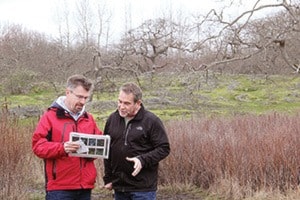More than just a pretty place, Uplands Park plays a key role in protecting natural heritage and biodiversity.
Boasting one of the highest concentrations of rare and endangered plants in Canada, the park contains the remnants of a rare ecosystem complex of Garry oak meadows and woodlands, maritime meadows and vernal pools, which used to cover a much greater area in the region.
More than 95 per cent of this habitat has been lost over the last century, said botanist Wylie Thomas who leads the reclamation project for the 32-hectare park.
Twenty-one rare and endangered plants are found in the open meadows and vernal pools of Uplands Park – some of which are found in only one or two other locations in Canada.
“What’s left is quite compromised,” Thomas said.
“These rare plants and ecosystems are under stress, and if we don’t address them now we risk losing an important part of what makes Uplands Park so special. In fact, we have lost at least five rare plant species in the last 20 years, and the populations of several extant species are in decline. We have also lost three rare butterflies since the 1950s.”
Invasive shrubs and trees prefer the same growing conditions as the rare plants, threatening their ability to grow.
Notorious Scotch broom, gorse and carpet burweed are joined by invasive trees slowly crowding the Garry oak, encroaching on the meadows.
Another major concern is trampling by park users both human and animal, particularly in wet weather. Some dogs also dig in the meadows and their owners don’t pick up droppings adding nutrients that favour the invasive plants.
For years, the District of Oak Bay, Friends of Uplands Park and volunteers have worked to mitigate the threats.
With 14 of the rare plants listed with the federal Species at Risk Act, the municipality scored funding from the federal Habitat Stewardship Program for seven of the last 10 years. Last year the $34,000 grant funding allowed for hiring a summer crew to remove invasive species. The district also provided in-kind support and Friends of Uplands Park.
“They did an amazing job last year with about 1,000 hours of volunteer time,” Thomas said of the organization that pulled invasive plants and replanted native ones. Staff and volunteers hauled out more than six truckloads (65 cubic yards) of chipped invasive trees and 15 trucks loads of loose materials such as Scotch broom and ivy.
The plantings came from Saanich Native Plants, donations from Thomas himself grown from seeds collected in the park and donations from other Oak Bay resident botanists and conservation biologists.
They planted 1,500 native plants and bulbs – representing more than 30 species – and sowed about 60,000 seeds. Oak Bay Parks also planted 10 Garry oaks and a native Black Hawthorn.
“From what it was to what it’s become is a real transformation. It’s still got a ways to go but we’re going to get there,” said Chris Hyde-Lay, parks manager.
Look for trail markings near the central meadow as Uplands Park undergoes another season of preservation this spring and summer as part of the ongoing park project.
“Right now it’s hard to say where to walk and that damages camas and rare plants,” Thomas said. “Whatever we do, we don’t want to interfere with people’s enjoyment of the park.”
Future work will see staff and volunteers continue to clear mature invasive trees from the centre of the park where the majority of the rare plants are found, continue to remove the smaller invasive plants from around the meadows and continue to install trail markers to encourage people to stay on paths.
“The goal is to reduce the threats posed by non-native trees and shrubs to levels sufficiently low that subsequent long-term control can be sustained by municipal parks staff and volunteers without additional support from the HSP,” Thomas said.
Learn more about opportunities to volunteer by visiting friendsofuplandspark.org online.
Did you know?
• The 14 plants listed under the federal Species at Risk Act are: Purple Sanicle, White-top Aster, Muhlenberg’s Centaury, Kellogg’s Rush, Twisted Oak-moss, Foothill Sedge, Banded Cord-moss, Coast Microseris, Macoun’s Meadowfoam, Tall Wooly-heads, Water-plantain Buttercup, Yellow Montane Violet, Victoria’s Owl-clover and Bearded Owl-clover. There are another seven provincially listed plants.
• Friends of Uplands Park gather to remove invasive plants March 27 from 1 to 4 p.m. The group will tackle carpet burweed, bur chervil, ivy and Daphne to aid the endangered Garry oak ecosystem. Students and children are welcome. No experience required; training and tools will be provided. Meet in the Cattle Point lower parking lot.
